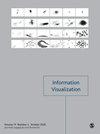STEP: Sequence of time-aligned edge plots
IF 1.8
4区 计算机科学
Q3 COMPUTER SCIENCE, SOFTWARE ENGINEERING
引用次数: 0
Abstract
We present sequence of time-aligned edge plots (STEP): a sequence- and edge-scalable visualization of dynamic networks and, more broadly, graph ensembles. We construct the graph sequence by ordering the individual graphs based on specific criteria, such as time for dynamic networks. To achieve scalability with respect to long sequences, we partition the sequence into equal-sized subsequences. Each subsequence is represented by a horizontal axis placed between two vertical axes. The horizontal axis depicts the order within the subsequence, while the two vertical axes depict the source and destination vertices. Edges within each subsequence are depicted as segmented lines extending from the source vertices on the left to the destination vertices on the right throughout the entire subsequence, and only the segments corresponding to the sequence members where the edges occur are drawn. By partitioning the sequence, STEP provides an overview of the graphs’ structural changes and avoids aspect ratio distortion. We showcase the utility of STEP for two realistic datasets. Additionally, we evaluate our approach by qualitatively comparing it against three state-of-the-art techniques using synthetic graphs with varying complexities. Furthermore, we evaluate the generalizability of STEP by applying it to a graph ensemble dataset from the architecture domain.STEP:时间对齐的边缘图序列
我们提出了时间对齐边缘图序列 (STEP):动态网络以及更广义的图形集合的序列和边缘可扩展可视化。我们根据特定标准(如动态网络的时间)对单个图形进行排序,从而构建图形序列。为了实现长序列的可扩展性,我们将序列划分为大小相等的子序列。每个子序列由两个纵轴之间的横轴表示。横轴表示子序列内的顺序,两个纵轴表示源顶点和目的顶点。在整个子序列中,每个子序列内的边被描绘成从左边的源顶点延伸到右边的目的顶点的分段线,并且只绘制与出现边的序列成员相对应的线段。通过对序列进行分割,STEP 可以提供图形结构变化的概览,并避免长宽比失真。我们在两个现实数据集上展示了 STEP 的实用性。此外,我们还使用具有不同复杂性的合成图形,将我们的方法与三种最先进的技术进行了定性比较,从而对我们的方法进行了评估。此外,我们还将 STEP 应用于建筑领域的图集合数据集,从而评估其通用性。
本文章由计算机程序翻译,如有差异,请以英文原文为准。
求助全文
约1分钟内获得全文
求助全文
来源期刊

Information Visualization
COMPUTER SCIENCE, SOFTWARE ENGINEERING-
CiteScore
5.40
自引率
0.00%
发文量
16
审稿时长
>12 weeks
期刊介绍:
Information Visualization is essential reading for researchers and practitioners of information visualization and is of interest to computer scientists and data analysts working on related specialisms. This journal is an international, peer-reviewed journal publishing articles on fundamental research and applications of information visualization. The journal acts as a dedicated forum for the theories, methodologies, techniques and evaluations of information visualization and its applications.
The journal is a core vehicle for developing a generic research agenda for the field by identifying and developing the unique and significant aspects of information visualization. Emphasis is placed on interdisciplinary material and on the close connection between theory and practice.
This journal is a member of the Committee on Publication Ethics (COPE).
 求助内容:
求助内容: 应助结果提醒方式:
应助结果提醒方式:


